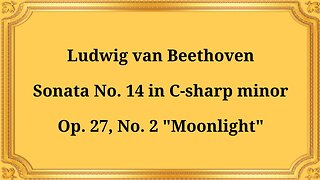Premium Only Content

Robert Schumann Piano Quintet in E flat, Op 44
#RobertSchumann #PianoQuintet #ClassicalMusic #MusicalComposition #EFlat #Op44 #ChamberMusic #MusicPerformance #MusicHistory #MusicAppreciation
Beaux Arts Trio, Samuel Rhodes
Robert Schumann's Piano Quintet in E flat, Op. 44 is a profound and influential composition that exemplifies the brilliance of the Romantic period. Written in 1842, this quintet is a captivating blend of melodic richness, expressive depth, and intricate harmonies.
Robert Schumann, a renowned German composer, created the Piano Quintet during a period of intense creativity. Composed in just a few weeks, it was dedicated to his wife Clara, who was an accomplished pianist. The quintet premiered in Leipzig in 1843, performed by Clara Schumann and a distinguished string quartet.
The Piano Quintet in E flat follows the traditional four-movement structure commonly found in chamber music compositions. The movements are as follows:
1. Allegro brillante: The opening movement bursts with energy and excitement. It introduces the main themes, showcasing Schumann's mastery of melodic development and harmonic complexity. The interplay between the piano and the string quartet creates a lively and spirited atmosphere.
2. In modo d'una marcia: This movement takes on the character of a funeral march, displaying Schumann's ability to evoke a range of emotions. It features somber and mournful melodies, interspersed with moments of intense passion. The use of imitative counterpoint adds depth and texture to the composition.
3. Scherzo: Molto vivace: The third movement is a playful scherzo, filled with rhythmic vitality and sparkling melodies. It showcases Schumann's skill in crafting intricate and lively music that captivates the listener. The contrasting trio section provides a moment of respite before the energetic scherzo returns.
4. Allegro ma non troppo: The final movement is a grand finale that brings the quintet to a satisfying conclusion. It is characterized by its driving rhythm, impassioned melodies, and rich harmonies. Schumann skillfully weaves together the piano and string instruments, creating a sense of unity and balance throughout the movement.
Schumann's Piano Quintet in E flat is known for its harmonic richness, lyrical beauty, and innovative use of musical motifs. The composition features intricate counterpoint, with each instrument having its own voice while contributing to the overall musical tapestry. Schumann's use of thematic development and variation adds depth and coherence to the piece, creating a sense of unity and emotional impact.
Conclusion:
Robert Schumann's Piano Quintet in E flat, Op. 44 stands as a testament to the composer's genius and his profound contribution to the Romantic period. Its combination of melodic beauty, harmonic complexity, and emotional depth make it a masterpiece of chamber music. This composition continues to captivate audiences with its expressive power and serves as a testament to Schumann's enduring legacy in the world of classical music.
You have the opportunity to support the channel:
https://destream.net/live/RadSiarAl/donate
https://www.buymeacoffee.com/6355radsiaral
-
 18:26
18:26
Classical music_Music Inspiration
1 month agoLudwig van Beethoven Sonata No. 14 in C-sharp minor, Op. 27, No. 2 "Moonlight"
741 -
 9:27
9:27
MattMorseTV
20 hours ago $7.13 earnedHe just lost EVERYTHING.
33.4K29 -

I_Came_With_Fire_Podcast
12 hours agoPrivate Military Contractors Are TRAFFICKING KIDS Around The United States
13.3K1 -
 LIVE
LIVE
JdaDelete
13 hours ago $0.63 earnedFinal Fantasy VII Rebirth | Jdub's Journey Part 8 - Corel Prison
251 watching -
 2:39:09
2:39:09
LFA TV
18 hours agoTHE ARK ENCOUNTER LIVE EVENT! 7.26.25 9AM EST-12PM EST
191K22 -
 LIVE
LIVE
Sgt Wilky Plays
2 hours agoTherapeutics with Dr Kong
89 watching -
 1:10:23
1:10:23
Man in America
23 hours agoAre MK-Ultra Parasites Rewiring Your Brain? | Detoxing, Peptides & Parasite Warfare w/ Diane Kazer
32.6K47 -
 LIVE
LIVE
TheSchleppy
23 hours ago $0.47 earned✨TheSchleppy✨24HR 2 YRS ON RUMBLE STREAM! RIGHT INTO RUMBLE HALO EVENT!
86 watching -
 3:08:21
3:08:21
JakRazGaming
3 hours agoPlaying Ghost of Tsushima DIRECTOR'S CUT!! on PS5 Stream 6
10.3K1 -
 29:06
29:06
Scary Mysteries
1 day agoThe Corpsewood Manor Murders: Satan, Secrets, and a Savage End
11.9K7